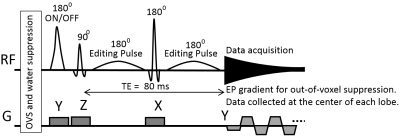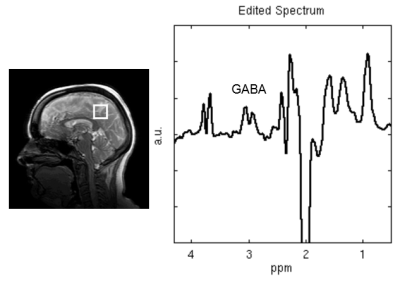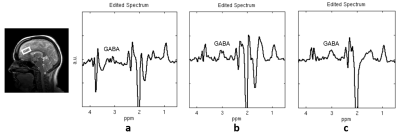3979
Macromolecule Suppressed GABA Editing with Reduced Artifact in Region near Sinuses using Improved MEGA-SPECIAL Sequence1Radiology, Stanford University, Stanford, CA, United States, 2Center for Cognitive and Neurobiological Imaging, Stanford University, Stanford, CA, United States
Synopsis
B0-inhomogeneity-insensitive GABA editing with MM suppression has been developed using improved MEGA-SPECIAL sequence using highly selective (30 ms) editing pulses allowed by 1D ISIS localization and 1D echo planar gradient in the logical S/I direction. MM suppressed GABA editing was successfully achieved in occipital lobe. However, GABA editing in regions near sinuses, e.g. anterior cingulate cortex (ACC), was compromised from imperfect subtraction in the ISIS localization. To reduce artifact in this region, the ISIS and 1D EP gradient were applied in the logical R/L direction together with a 16-step phase-cycled acquisition. These methods significantly improved edited spectra obtained from ACC.
Introduction
In-vivo measurement of Gamma-aminobutyric-acid (GABA) using magnetic resonance spectroscopy (MRS) offers valuable information for understanding brain function. Based on J-difference editing, the most widely used sequence for MRS GABA detection is TE 68 ms MEGA-PRESS, where the editing pulse is applied to GABA C3 resonance at 1.9 ppm for the "ON" case to flip the outer peaks of its C4 triplet resonance at 3 ppm.1 The major problem with this editing scheme is the coediting of the macromolecules due to the wide transition band of the editing pulses. At 14-16 ms editing pulse duration, MM typically contribute 40% to 60% to the 3 ppm resonance in the edited spectrum, complicating the quantification of GABA. As a result, the 3 ppm resonance in the non-MM-suppressed edited spectrum is often labeled as GABA+.
Recently, B0-inhomogeneity-insensitive GABA editing with MM suppression has been developed using improved MEGA-SPECIAL sequence.2 Based on 1D ISIS spatial localization and single spin echo, this editing technique allows much longer (30 ms) and more selective editing pulses than used in MEGA-PRESS. To reduce susceptibility and motion artifacts in the ISIS direction, out-of-voxel suppression was achieved using a 1D echo planar (EP) gradient during readout. With ISIS and 1D EP gradient applied in the logical S/I direction, MM-suppressed GABA editing was successfully achieved in brain regions such as occipital lobe (OCC) and dorsolateral prefrontal cortex (DLPFC). However, GABA editing in regions near sinuses, e.g. anterior cingulate cortex (ACC), was compromised by artifacts from imperfect subtraction in the ISIS localization. To reduce artifact in region near sinuses, we propose using the improved MEGA-SPECIAL sequence with the ISIS and 1D EP gradient in the logical R/L direction together with a 16 step phase cycled acquisition.
Methods
Improved MEGA-SPECIAL sequence with the 1D EP gradient in the logical R/L for out-of-voxel artifact suppression is shown in Figure 1. Localization in S/I direction was achieved using the excitation RF pulse with high bandwidth. The 16 step phase cycling consists (00, 1800) for the ISIS inversion RF pulse, (00, 1800, 900, 2700) for the refocusing RF pulse and (00, 1800) for the excitation RF pulse. Each phase cycling step was applied to the four readouts (ISIS Off/Editing Off, ISIS On/Editing Off, ISIS Off/Editing On, ISIS On/Editing On) for both ISIS localization and GABA editing. In vivo MRS data were acquired on a GE 750 3T scanner using a Nova 32 channel coil with TE/TR=80ms/2s, 256 transients, 8:40 minute scan time.Results
A representative edited spectrum from voxels in OCC using the original improved MEGA-SPECIAL, i.e. ISIS and 1D EP gradient applied in the logical S/I direction without phase cycling, is shown in Figure 2. In these regions, high quality edited spectra without noticeable artifacts were obtained using the original improved MEGA-SPECIAL sequence. A representative edited spectrum from voxels in ACC with significant artifact using the original improved MEGA-SPECIAL is shown in Figure 3(a). Figure 3(b) shows the edited spectrum from the same voxel in ACC with significantly reduced artifact using the improved MEGA-SPECIAL with the proposed localization gradient order but without phase cycling. The edited spectrum from the same voxel with further reduced artifact using the improved MEGA-SPECIAL with the proposed localization gradient order and a 16 step phase cycling acquisition is shown in Figure 3(c).Conclusions
Applying ISIS and 1D EP gradient in the logical R/L direction using the improved MEGA-SPECIAL sequence significantly reduces artifact for MM suppressed GABA editing. Artifact in the edited spectra is further suppressed using a 16 step phase cycling.Acknowledgements
NIH grants P41EB015891, MH110683 and R01HD084214, the Lucas Foundation, GE Health Care, and the, Stanford Center for Cognitive and Neurobiological ImagingReferences
1. Mescher M, Merkle H, Kirsch J, Garwood M, Gruetter R. Simultaneous in vivo spectral editing and water suppression. NMR Biomed. 1998;11(6):266-72.
2. Gu M, Hurd R, Noeske R, Baltusis L, Hancock R, Sacchet MD, Gotlib IH, Chin FT, Spielman DM. GABA editing with macromolecule suppression using an improved MEGA-SPECIAL sequence. Magn Reson Med. 2017 Mar 31. doi: 10.1002/mrm.26691.
Figures


